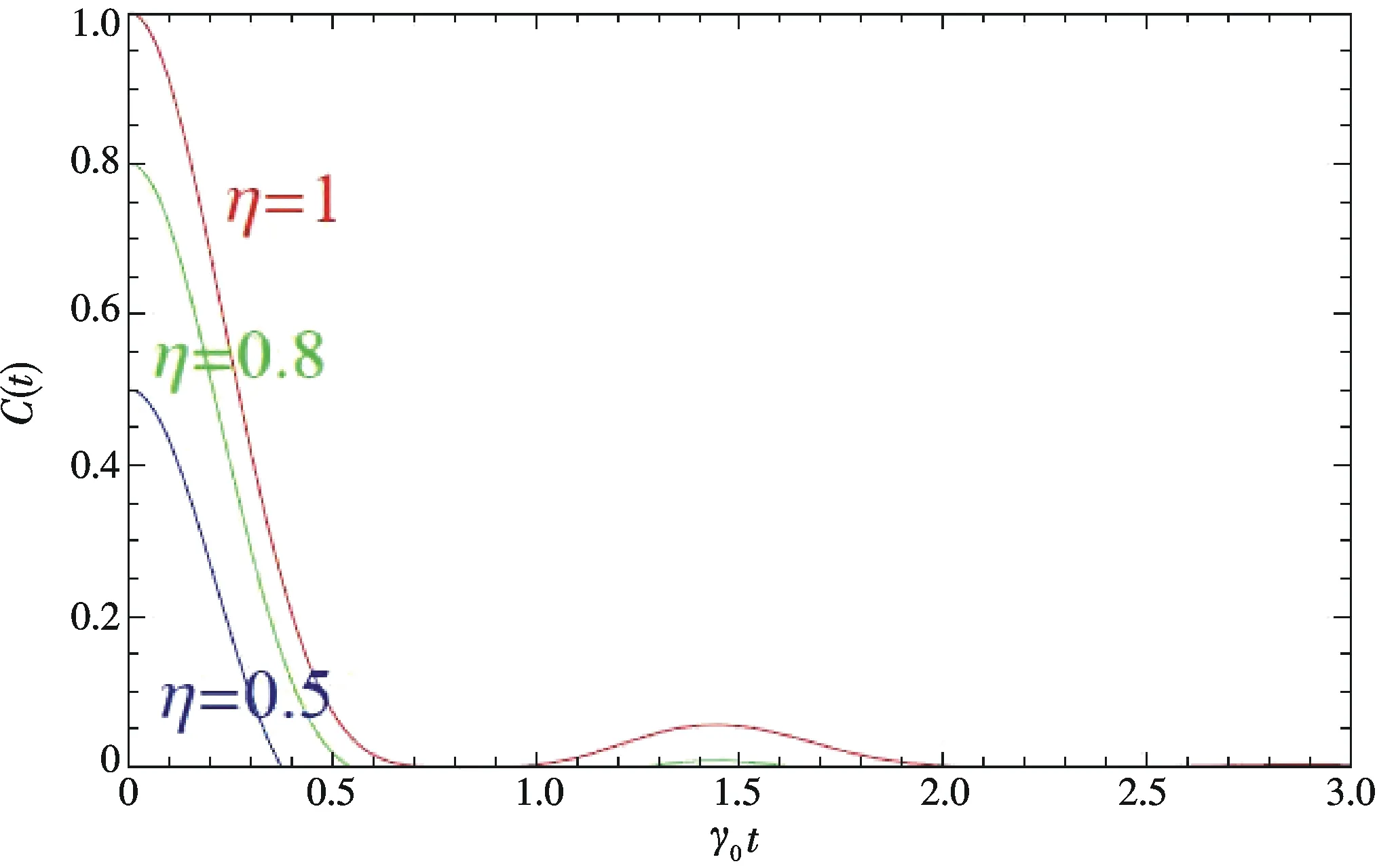Non-Markovian Effects on the Dynamics of Entanglement in Real Environment
2016-11-29ZHANQiangLIMingshiYEZhitingYEGuangyuanLIUZhenkaoWANGShihongHUANGJiang
ZHAN Qiang,LI Ming-shi,YE Zhi-ting,YE Guang-yuan,LIU Zhen-kao,WANG Shi-hong,HUANG Jiang
(Physical and Photoelectric Science Department,Guangdong Ocean University,Zhanjiang 524088,China)
Non-Markovian Effects on the Dynamics of Entanglement in Real Environment
ZHAN Qiang,LI Ming-shi,YE Zhi-ting,YE Guang-yuan,LIU Zhen-kao,WANG Shi-hong,HUANG Jiang*
(Physical and Photoelectric Science Department,Guangdong Ocean University,Zhanjiang 524088,China)
By considering the influence of the environmental disorder in the non-local decoherence system,the non-Markovian entanglement dynamics of two independent qubits was investigated.With the simulation of the environment noise as external entities,the preservation of entanglement depends on the environmental disorder was found.Its corresponding physical mechanism is also given.
non-Markovian; entanglement; non-local
All realistic quantum systems are unavoidable to interact with its environments that occurs the so-called dissipation and decoherence,the dissipation and decoherence quantum dynamics of quantum cavities have been studied for decades because it is the bases of quantum communication and information[1-5].Taking into account the influence of the environment on the quantum dynamics evolution makes the systems more complicate and interesting[6-7].We can mainly classify the quantum dynamical processes into Markovian processes with no memory effect and non-Markovian processes with memory effect,according to the environmental characters.Most of the studies are interested with the information between the system and reservoir,to investigate their characters.For memoryless Markovian open systems,the system information losses to the environment monotonically,and the last time is relatively short.So it has many limitation for further investigation.However,in the non-Markovian case,employing the memory effect,the lost information will return to the system at a later time during the interaction.This phenomenon arouses researchers much interest,and many works related with non-Markovian dynamics have been done[8-11]recently.Between the works,Breuer et al raised a theorem called the degree of non-Markovianity which can be used to study the non-Markovian dynamics quantitatively in Ref.[12].They calculate the changing rate of trace distance as a criterion to distinguish the states.The increment is interpreted as the return back information flow form the reservoir to the system.
However,the realistic environment is not easy to control,and it will cause decoherence.In this paper,we import a system M to simulate the environment and use the amplitude damping channel to research its characteristic.The article is organized as follows: In Sec.2,we introduce our mode and build the initial states.Then the time-dependent evolution is calculated in Sec.3.In Sec.4 we use concurrence to study entanglement evolution and the analysis is given,too.At last,we conclude the paper simply.
1 The Model



We prepare the initial state as the not quite perfect Bell state:
|Φ〉AB=cosθ|e〉Ae〉|B+sinθ|g〉A|g〉B,
where |e〉Aand |g〉Aare orthogonal states of qubit A,and the same as B,and mean as the excited and ground states.As we know,in reality,every system can not avoid the effect of its environment,and a state will deviate from the ideal target state.Now we construct a new model to describe how this might occur.It is coupled to an environment that will cause postpreparation decoherence,and also still entangled with marginal entities denotes by M[13].We write the initial state as:
|Φ(0)〉=[cosθ|e〉A|e〉B|m1〉+sinθ|g〉A|g〉B|m2〉]⊗|φ0〉a|φ0〉b,
(1)
where |m1〉 and |m2〉 are normalized states of the marginal system M,and |φ0〉aand |φ0〉bare the normalized states of the environmental reservoirs a and b,respectively.Imperfect control of the preparation leads to a possibly mixed rather than pure initial state with the relation η=〈m2|m1〉,here η represents the environmental disorder with a span 0≤η≤1.η=0 means the environment is totally disordered,and η=1 means the ideal environment.It is easy to write out the initial two-qubit reduced density matrix:

2 States evolution
Now we consider the time-dependent dynamics of the two-qubit entanglement to see how it is affected by the initial state specification.Each qubit takes the same amplitude damping process[14-16]:
|g〉A|φ0〉a→|g〉A|φ0〉a,
(2)

(3)
where |φ〉ais another environmental reservoir state witha〈φ1|φ0〉b=0,and Pa(t)is the probability that qubit A remains in its excited state,here Pa(t)obeys the differential equation:

and f(t-t1)is the correlation function which is related to the spectral density J(ω)of the reservoir:
f(t-t1)=∫dωJ(ω)exp[i(ω0-ω)(t-t1)],
The exact form of Pa(t)depends on the particular choice for the spectral density of the reservoir.We take J(ω)as the Lorentzian form:



We solve the Pa(t)as:

From Eq.(1),(2)and (3)we can calculate the time dependent state



3 Entanglement evolution and analysis


arranged in decreasing order.Here ρ*Tdenotes the complex conjugation of ρTin the standard basis,and σyis the well-known Pauli matrix expressed in the same basis.The concurrence varies from C=0 for a disentangled state to C=1 for a maximally entangled state.The two-party entanglement obeys the X-state formula[18]

Now we analyze the evolution regulation of entanglement.We draw Fig.1 to make a comparison between the Markovian and non-Markovian regime.

Fig.1 (Color online)Time-dependent surfaces showing entanglement evolution parameterized in two regime: Left for λ=5γ0 which is in the Markovian regime; Right for λ=0.1γ0 which is in the non-Markovian regime.Here we order η=0.9
It is obvious that in Markovian regime the concurrence C(t)decays exponentially but in non-Markovian regime the evolution curve appears revival effect which is already explained in Ref.[1].In order to investigate the parameter η,we draw Fig.2.The two figures parameters have no difference but the value of η.

Fig.2 (Color online)Time-dependent surfaces showing entanglement evolution in non-Markovian regime with λ=0.1γ0; Left for η=1; Right for η=0.6
Making an easy comparison with them we find that η is greatly affected the concurrence.When η=1,it represents the environment is an ideal external system,this result returns to Ref.[14].We both have the identical conclusion.Then we order η=0.6 for the right figure,the maximum value of C(t)turns down and the non-Markovian effect is not as obvious as before.It is not hard to explain this phenomenon,the critical factor is the environmental disorder.Then environment is more disorder,the more information could loss,and the revival effect is not obvious naturally.To proof our conclusion,we draw Fig.3 to give a more clear explanation go a step.From Fig.3 we can see that the bigger η is,the larger is C(t),which follows the same regulation.

Fig.3 (Color online)Concurrence against with the dimensionless quantity γ0t in non-Markovian regime at ρ11=0.5.The red line is for η=1,the green line is for η=0.8,and the blue line is for η=0.5
4 Conclusion
In conclusion,we have investigated the behavior of non-local decoherence in this paper.We choose the not quite perfect Bell state as the initial condition and employ a system M to consider the effect of the environment.After the amplitude damping process,we trace off the external entities to get the reduced density matrix which has the X-style.Considering the concurrence of entanglement in the Markovian and non-Markovian regime,we find that the entanglement is greatly affected by the environmental disorder.The results are identical with Ref.[14].The work provide a method to transfer entangled communication effectively.
[1] BREUER H P,PETRUCCIONE F.The theory of open quantum systems[M].Oxford: Oxford University Press,2007.
[2] WEISS U.Quantum dissipative systems[M].World Scientific: Singapore Press,2008.
[3] ZHU C W,SONG M S,HU G X,etal.Dynamic theory of die swell for entangled polymeric liquids in tube extrusions: new set of equations for the growth and ultimate extrudate swelling ratios under the free states[J].Phys Chem,2007,20(5):563-581.
[4] HUANG J,ZHAN Q,LIU Z K.Ehancing the precision of parameter estimation in band gap[J].Theor Phys,2016,55(5):3026-1-3026-7.
[5] MAD P,CACHEFFO A.VILLAS B C J,etal.Spontaneous recoherence of quantum states after decoherence[J].Eur Phys J D,2010,59(3):487-496.
[6] VAIDMAN L,GOLDENBERG L,WIESNER S.Error prevention scheme with four particles[J].Phys Rev A,1996,54(3):R1745-R1748.
[7] HE Z,ZOU J,LI L,etal.An effective method of calculating the non-Markovianity for single channel open systems[J].Phys Rev A,2011,83(1):012108.
[8] REVAS A,HUELGA S F,PLENIO M B.Entanglement and non-markovianity of quantum evolutions[J].Phys Rev Lett,2010,105(5):2053-2097.
[9] BREUER H P,PILLO J.Stochastic jump processes for non-Markovian quantum dynamics[J].Europhys Lett,2009,85(5):50004.
[10] DING B F,WANG X Y,LIU J F,etal.Quantum discord dynamics in two different non-Markovian reservoirs[J].Chin Phys Lett,2011,28(10):104216.
[11] XU G T,TONG D M.Non-Markovian effect on the classical and quantum correlations[J].Chin Phys Lett,2011,28(6):060305.
[12] BREUER H P,LAINEE E M,PILLO J.Measure for the degree of non-markovian behavior of quantum processes in open systems[J].Phys Rev Lett,2009,103(21): 210401.
[13] QIAN X F,EBERLY J H.Entangled states of light in classical polarization theory[J].Optics Lett,2010,36(20):4110.
[14] BELLOMO B,FRANCO R L,COMPAGNO G.Non-markovian effects on the dynamics of entanglement[J].Phys Rev Lett,2007,99(16):160502.
[15] COCHEANE P T.MILBURN G J,MUNRO W J.Macroscopically distinct quantum superposition states as a bosonic code for amplitude damping[J].Phys Rev A,1999,59(4):2631-2634.
[16] LIN Q,LI J,GUO G C.Linear optical realization of qubit purification with quantum amplitude damping channel[J].Chin Phys Lett,2007,27(7):1809-1812.
[17] WOOTTERS W K.Entanglement of formation of an arbitrary state of two qubits[J].Phys Rev Lett,1998,80(10):2245.
[18] YU T,EBERLY J H.Zero-error attacks and detection statistics in the coherent one-way protocol for quantum cryptography[J].Quant Inf Comp,2007,7(7):459.9
(编辑 CXM)
2016-05-07
广东省自然科学基金资助项目(2015A030310354);广东省教育厅青年创新人才类资助项目(2015KQNCX059);广东海洋大学创新强校工程(GDOU2016050220);2015年“海之帆——起航计划”大学生科技创新项目(hzfqhjhzrkx2015b11,hzfqhjhkjfm2015b09);2016年度广东海洋大学大学生创新创业训练计划立项项目(CXXL2016080、CXXL2016087)
O413.2
A
1000-2537(2016)05-0065-05
在真实环境中纠缠动力学的非马尔科夫效应
詹 强,李铭仕,叶智婷,叶广源,刘振考,王世洪,黄 江*
(广东海洋大学物理与光电科学系,中国 湛江 524088)
在非局域退相干系统中,研究了环境紊乱程度对两体非马尔科夫纠缠动力学的影响.通过模拟环境的噪声,发现了纠缠保持依赖与环境的紊乱程度.并给出了相应的物理机制.
非马尔科夫;纠缠;非局域
10.7612/j.issn.1000-2537.2016.05.011
*通讯作者,E-mail:940038299@qq.com
